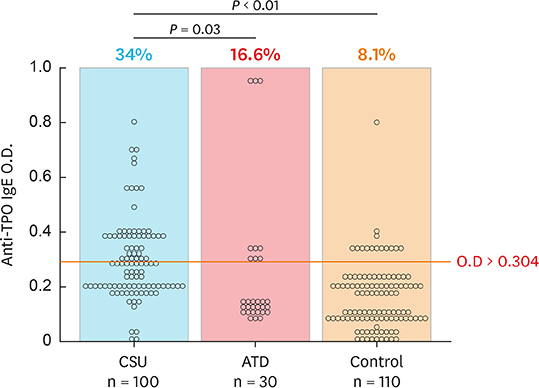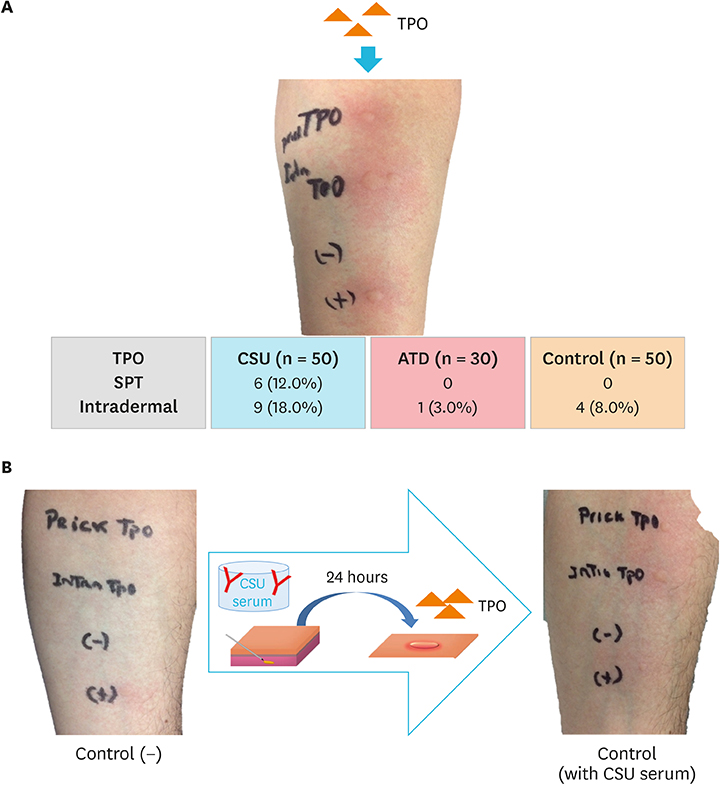Allergy Asthma Immunol Res.
2019 Jan;11(1):29-42. 10.4168/aair.2019.11.1.29.
Causal Relationship Between Anti-TPO IgE and Chronic Urticaria by In Vitro and In Vivo Tests
- Affiliations
-
- 1Group of Experimental and Clinical Allergy, IPS Universitaria, University of Antioquia, MedellÃn, Colombia. jotamsc@yahoo.com
- 2Foundation for the Development of Medical and Biological Sciences, Cartagena, Colombia.
- 3Immunology Department, University Corporation Rafael Núñez, Cartagena, Colombia.
- KMID: 2426783
- DOI: http://doi.org/10.4168/aair.2019.11.1.29
Abstract
- PURPOSE
Immunoglobulin (Ig) E autoantibodies against thyroid antigens such as thyroid peroxidase (TPO) have been demonstrated in chronic spontaneous urticaria (CSU) patients in higher frequency than healthy subjects. However, if these IgE autoantibodies can trigger urticaria is still a matter of study. The aim of this study was to investigate the relationship between concomitant IgE autoantibodies against thyroid antigens in CSU.
METHODS
Patients with CSU, healthy subjects and patients with autoimmune thyroid disease (ATD) were recruited. Total IgE and specific anti-TPO IgE and IgG were assessed in all subjects. The basophil activation test and skin tests with TPO were performed to demonstrate whether this antigen could selectively induce urticaria reaction in subjects with positive anti-TPO IgE.
RESULTS
Anti-TPO IgE was present in all 3 groups (CSU: 34.0%, ATD: 16.6%, healthy subjects: 8.1%). Anti-TPO IgE levels were higher in CSU patients, whereas anti-TPO IgG were higher in ATD patients. After exposure to TPO, CD203c expression from patients with CSU and anti-TPO IgE significantly increased in comparison to the other groups; 33.0% vs. 14.0% in ATD patients and 9.0% in control subjects (P < 0.05). Skin reactions with TPO were higher in patients with CSU according to the intradermal (CSU: 18.0%, ATD: 3.3%, control: 8.0%) and skin prick tests (12.0%, 0%, 0%, respectively). Passive transfer of anti-TPO IgE from a CSU patient to the skin of control subjects without anti-TPO IgE induced a positive skin reaction.
CONCLUSIONS
Anti-TPO IgE is not a specific biomarker for CSU. However, IgE against TPO plays a pathogenic role in inducing effector cell activation and skin exacerbation in some patients with CSU.
Keyword
MeSH Terms
Figure
Cited by 1 articles
-
Natural History of Chronic Urticaria in Korea
Bo Young Chung, Ji-young Um, Seok Young Kang, Hye One Kim, Chun Wook Park
Ann Dermatol. 2020;32(1):38-46. doi: 10.5021/ad.2020.32.1.38.
Reference
-
1. Kolkhir P, Borzova E, Grattan C, Asero R, Pogorelov D, Maurer M. Autoimmune comorbidity in chronic spontaneous urticaria: a systematic review. Autoimmun Rev. 2017; 16:1196–1208.
Article2. Kaplan AP. Chronic spontaneous urticaria: pathogenesis and treatment considerations. Allergy Asthma Immunol Res. 2017; 9:477–482.
Article3. Grattan CE, Francis DM, Hide M, Greaves MW. Detection of circulating histamine releasing autoantibodies with functional properties of anti-IgE in chronic urticaria. Clin Exp Allergy. 1991; 21:695–704.
Article4. Hide M, Francis DM, Grattan CE, Hakimi J, Kochan JP, Greaves MW. Autoantibodies against the high-affinity IgE receptor as a cause of histamine release in chronic urticaria. N Engl J Med. 1993; 328:1599–1604.
Article5. Bar-Sela S, Reshef T, Mekori YA. IgE antithyroid microsomal antibodies in a patient with chronic urticaria. J Allergy Clin Immunol. 1999; 103:1216–1217.
Article6. Concha LB, Chang CC, Szema AM, Dattwyler RJ, Carlson HE. IgE antithyroid antibodies in patients with Hashimoto's disease and chronic urticaria. Allergy Asthma Proc. 2004; 25:293–296.7. Kolkhir P, Metz M, Altrichter S, Maurer M. Comorbidity of chronic spontaneous urticaria and autoimmune thyroid diseases: a systematic review. Allergy. 2017; 72:1440–1460.
Article8. Altrichter S, Peter HJ, Pisarevskaja D, Metz M, Martus P, Maurer M. IgE mediated autoallergy against thyroid peroxidase--a novel pathomechanism of chronic spontaneous urticaria? PLoS One. 2011; 6:e14794.9. Shin YS, Suh DH, Yang EM, Ye YM, Park HS. Serum specific IgE to thyroid peroxidase activates basophils in aspirin intolerant urticaria. J Korean Med Sci. 2015; 30:705–709.
Article10. Sánchez J, Amaya E, Acevedo A, Celis A, Caraballo D, Cardona R. Prevalence of inducible urticaria in patients with chronic spontaneous urticaria: associated risk factors. J Allergy Clin Immunol Pract. 2017; 5:464–470.
Article11. Sánchez J, Zakzuk J, Cardona R. Prediction of the efficacy of antihistamines in chronic spontaneous urticaria based on initial suppression of the histamine- induced wheal. J Investig Allergol Clin Immunol. 2016; 26:177–184.
Article12. Zuberbier T, Aberer W, Asero R, Bindslev-Jensen C, Brzoza Z, Canonica GW, et al. The EAACI/GA(2) LEN/EDF/WAO Guideline for the definition, classification, diagnosis, and management of urticaria: the 2013 revision and update. Allergy. 2014; 69:868–887.13. Ross DS, Burch HB, Cooper DS, Greenlee MC, Laurberg P, Maia AL, et al. 2016 American Thyroid Association guidelines for diagnosis and management of hyperthyroidism and other causes of thyrotoxicosis. Thyroid. 2016; 26:1343–1421.
Article14. Ye YM, Yang EM, Yoo HS, Shin YS, Kim SH, Park HS. Increased level of basophil CD203c expression predicts severe chronic urticaria. J Korean Med Sci. 2014; 29:43–47.
Article15. Konstantinou GN, Asero R, Maurer M, Sabroe RA, Schmid-Grendelmeier P, Grattan CE. EAACI/GA(2)LEN task force consensus report: the autologous serum skin test in urticaria. Allergy. 2009; 64:1256–1268.
Article16. Bousquet J, Heinzerling L, Bachert C, Papadopoulos NG, Bousquet PJ, Burney PG, et al. Practical guide to skin prick tests in allergy to aeroallergens. Allergy. 2012; 67:18–24.17. Heinzerling LM, Burbach GJ, Edenharter G, Bachert C, Bindslev-Jensen C, Bonini S, et al. GA(2)LEN skin test study I: GA(2)LEN harmonization of skin prick testing: novel sensitization patterns for inhalant allergens in Europe. Allergy. 2009; 64:1498–1506.18. Meulenbroek LA, de Jong RJ, den Hartog Jager CF, Monsuur HN, Wouters D, Nauta AJ, et al. IgG antibodies in food allergy influence allergen-antibody complex formation and binding to B cells: a role for complement receptors. J Immunol. 2013; 191:3526–3533.
Article19. Fagiolo U, Kricek F, Ruf C, Peserico A, Amadori A, Cancian M. Effects of complement inactivation and IgG depletion on skin reactivity to autologous serum in chronic idiopathic urticaria. J Allergy Clin Immunol. 2000; 106:567–572.
Article20. Sánchez-Caraballo J, Diez-Zuluaga S, Cardona-Villa R. Sensibilización a aeroalergenos en pacientes alérgicos de Medellín, Colombia. Rev Alerg Mex. 2012; 59:139–147.21. Leznoff A, Sussman GL. Syndrome of idiopathic chronic urticaria and angioedema with thyroid autoimmunity: a study of 90 patients. J Allergy Clin Immunol. 1989; 84:66–71.
Article22. Turktas I, Gokcora N, Demirsoy S, Cakir N, Onal E. The association of chronic urticaria and angioedema with autoimmune thyroiditis. Int J Dermatol. 1997; 36:187–190.
Article23. Verneuil L, Leconte C, Ballet JJ, Coffin C, Laroche D, Izard JP, et al. Association between chronic urticaria and thyroid autoimmunity: a prospective study involving 99 patients. Dermatology. 2004; 208:98–103.
Article24. Palma-Carlos AG, Palma-Carlos ML. Chronic urticaria and thyroid auto-immunity. Eur Ann Allergy Clin Immunol. 2005; 37:143–146.25. Cebeci F, Tanrikut A, Topcu E, Onsun N, Kurtulmus N, Uras AR. Association between chronic urticaria and thyroid autoimmunity. Eur J Dermatol. 2006; 16:402–405.26. Rottem M. Chronic urticaria and autoimmune thyroid disease: is there a link? Autoimmun Rev. 2003; 2:69–72.
Article27. Confino-Cohen R, Chodick G, Shalev V, Leshno M, Kimhi O, Goldberg A. Chronic urticaria and autoimmunity: associations found in a large population study. J Allergy Clin Immunol. 2012; 129:1307–1313.
Article28. Magen E, Mishal J. The effect of L-thyroxine treatment on chronic idiopathic urticaria and autoimmune thyroiditis. Int J Dermatol. 2012; 51:94–97.
Article29. Najib U, Bajwa ZH, Ostro MG, Sheikh J. A retrospective review of clinical presentation, thyroid autoimmunity, laboratory characteristics, and therapies used in patients with chronic idiopathic urticaria. Ann Allergy Asthma Immunol. 2009; 103:496–501.
Article30. Schmetzer O, Lakin E, Topal FA, Preusse P, Freier D, Church MK, et al. IL-24 is a common and specific autoantigen of IgE in patients with chronic spontaneous urticaria. J Allergy Clin Immunol. 2017; S0091-6749(17)31875-4.
Article31. Altman K, Chang C. Pathogenic intracellular and autoimmune mechanisms in urticaria and angioedema. Clin Rev Allergy Immunol. 2013; 45:47–62.
Article32. Mozena JD, Tiñana A, Negri J, Steinke JW, Borish L. Lack of a role for cross-reacting anti-thyroid antibodies in chronic idiopathic urticaria. J Invest Dermatol. 2010; 130:1860–1865.
Article33. Rauber MM, Pickert J, Holiangu L, Möbs C, Pfützner W. Functional and phenotypic analysis of basophils allows determining distinct subtypes in patients with chronic urticaria. Allergy. 2017; 72:1904–1911.
Article34. Eberlein-König B, Varga R, Mempel M, Darsow U, Behrendt H, Ring J. Comparison of basophil activation tests using CD63 or CD203c expression in patients with insect venom allergy. Allergy. 2006; 61:1084–1085.
Article35. MacGlashan D Jr. Expression of CD203c and CD63 in human basophils: relationship to differential regulation of piecemeal and anaphylactic degranulation processes. Clin Exp Allergy. 2010; 40:1365–1377.
Article36. Abuaf N, Rostane H, Rajoely B, Gaouar H, Autegarden JE, Leynadier F, et al. Comparison of two basophil activation markers CD63 and CD203c in the diagnosis of amoxicillin allergy. Clin Exp Allergy. 2008; 38:921–928.
Article37. Nguyen KL, Gillis S, MacGlashan DW Jr. A comparative study of releasing and nonreleasing human basophils: nonreleasing basophils lack an early component of the signal transduction pathway that follows IgE cross-linking. J Allergy Clin Immunol. 1990; 85:1020–1029.
Article38. Saini S, Rosen KE, Hsieh HJ, Wong DA, Conner E, Kaplan A, et al. A randomized, placebo-controlled, dose-ranging study of single-dose omalizumab in patients with H1-antihistamine-refractory chronic idiopathic urticaria. J Allergy Clin Immunol. 2011; 128:567–573.e1.
Article39. Kim YS, Han K, Lee JH, Kim NI, Roh JY, Seo SJ, et al. Increased risk of chronic spontaneous urticaria in patients with autoimmune thyroid diseases: a nationwide, population-based study. Allergy Asthma Immunol Res. 2017; 9:373–377.
Article40. Haahtela T, Burbach GJ, Bachert C, Bindslev-Jensen C, Bonini S, Bousquet J, et al. Clinical relevance is associated with allergen-specific wheal size in skin prick testing. Clin Exp Allergy. 2014; 44:407–416.
Article
- Full Text Links
- Actions
-
Cited
- CITED
-
- Close
- Share
- Similar articles
-
- Serum Specific IgE to Thyroid Peroxidase Activates Basophils in Aspirin Intolerant Urticaria
- Anti-TPO IgE Autoantibody in Chronic Urticaria: Is It Clinically Relevant?
- Autoantibody Against High Affinity IgE Receptor In Chronic Idiopathic Urticaria
- Evaluation for Historical and Laboratory Tests in Patients with Urticaria
- Correlation between Results of the Multiple Allergosorbent Test-Chemiluminescent Assay (MAST-CLA) and Clinical Severity of Chronic Urticaria




